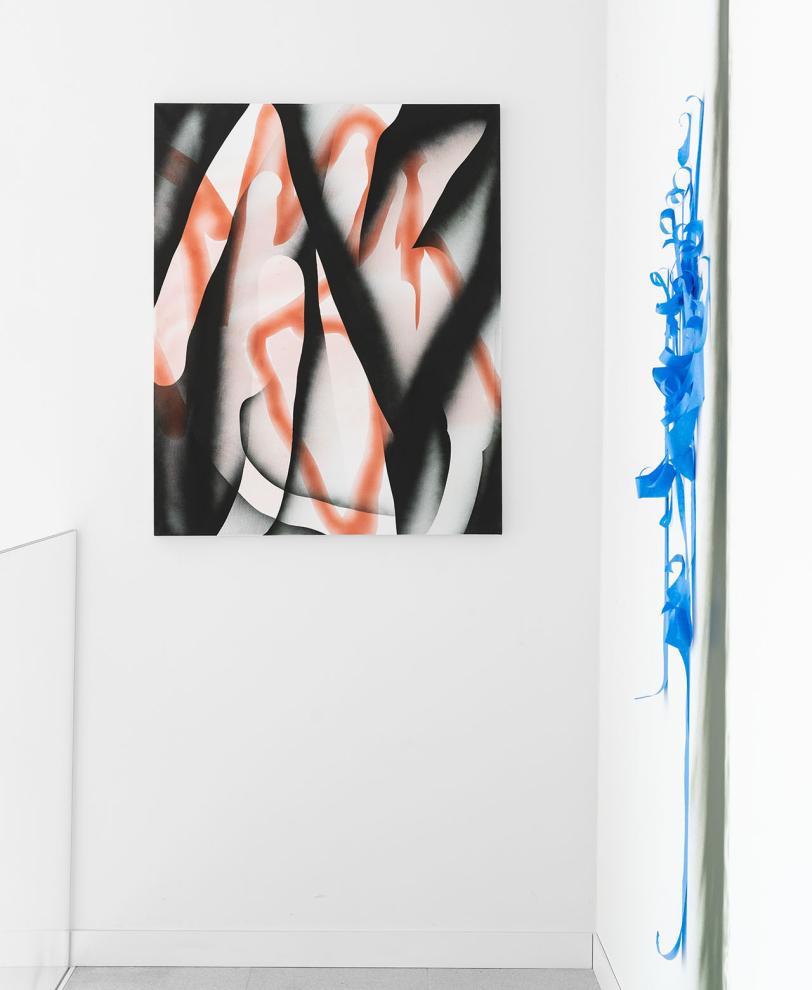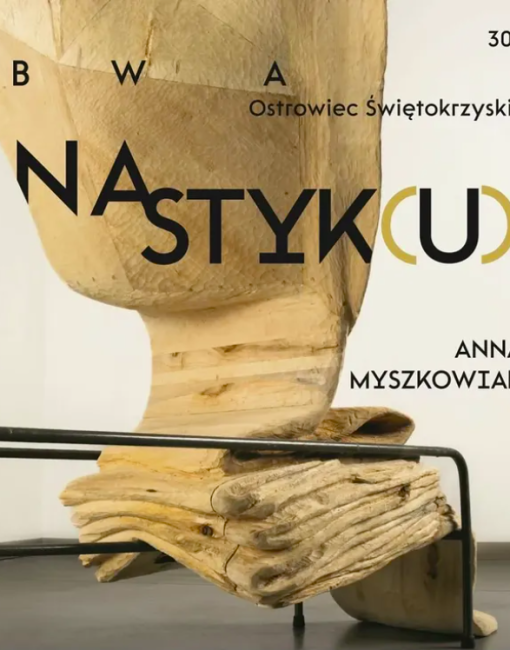
Stach Szabłowski review of Sebastian Krzywak's exhibition "Eraserhead"
Superimposition and mirage
Paintings hanging on a wall for a long time leave a mark, a smudged contour often referred to as the ghost. Sebastian Krzywak evokes a ghost in front of the entrance to the exhibition space of his solo show in the Molski Gallery & Collection. In this case, it is the ghost of a painting that has never been displayed here in the first place. It has never been erased by time and dust, but simply sprayed on – blue masking tape stuck to the wall around a dark green rectangle.
The composition has no title. Strictly speaking, it is not even an art piece. It is a negative of a painting (paint is placed outside the canvas, which one would also look for in vain), visual citation transferred to the gallery from the artist’s studio, where these kinds of ghosts abound.
Rarely do ghosts make themselves known without any reason. Their presence is meaningful; they manifest themselves to communicate something. Here, Krzywak invokes a mirage of his studio, thus suggesting that a person looking at the paintings should always be mindful of the creative process. Silhouette of an absent work leaves an empty space on the wall; a screen onto which the recurring themes of Krzywak’s practice are projected – these are meditations on the ontology of the contemporary painting as well as its place in the visual culture spanning both the physical and digital spheres of reality.
*
Questions raised by Krzywak resound with the echo of the discourse articulating the sensibility that in the last decade earned the post-internet moniker. In his essay on the artistic practice of a painter, Przemek Sowiński, an artist, critic and founder of the Łęctwo Gallery, called it post-analogous instead. Both terms point to the same direction, namely a reflection on the position of painting in the face of the digital revolution.
“Has the protagonist of the Polish novel already bought himself a computer?,” asks Adam Wrotz in the widely discussed article on the condition of literature in Poland that was published in the online magazine Dwutygodnik in 2023.[1] The author argues, among other things, that it is increasingly difficult to create cultural texts that touch on contemporary life in a meaningful way without taking into account how new technologies have altered the perception and experience of the world.
Sebastian Krzywak bought a computer a long time ago.
*
In 1839, Louis Mandé Daguerre was invited to demonstrate his invention of photography to the artists at the Académie des Beaux-Arts in Paris. After his presentation, Paul Delaroche, one of the brightest stars among the French painters, declared the death of painting. He was wrong. Photography did not kill the painting, only transformed it thoroughly.
New imaging technologies keep emerging. Picture what Delaroche would say if he saw the images generated today by AI protocols. No one proclaims that the painting is dead anymore. Too many times have these sorts of statements been made prematurely and falsely. Nonetheless, the evolution of art under duress of technological advancement is very much ongoing. If 19th-century photography redefined the notion of representation of reality in painting, the digital revolution has exerted an even more profound influence on the discipline, affecting not only the structure but also the physical manifestation of an image.
Photography propelled painting towards the autonomization of its language, towards independence that resonates most powerfully in the discourse of abstraction. Is Sebastian Krzywak an abstract painter? The artist himself admits that he is fascinated by colour field painting and the American painting of the 1950s. Seeking references to art history in his practice, one would arrive at the obvious associations with the postwar movements of lyrical abstraction and informalism. However, in the context of a post-analogous (and post-internet) age one would simply need to mention contemporary painting taking a departure from representation in the post-abstract sense. Let us then concede that Krzywak’s paintings are non-representational, meaning they invite one to concentrate on the image itself, and not on any object of representation that could be portrayed by or alluded to by a painting. Despite this fact (or because of it), the artist leaves an answer to the question “What are we seeing?” to the viewer – not only do the paintings provide visual satisfaction, but they also trigger a series of associations. At first glance, the forms created by Krzywak seem organic, and so they galvanise us into looking for their reflections in nature. The question is whether this line of thinking would lead us astray into overinterpretation.
Before we even attempt to answer this question, let us stifle the urge to approach every non-representational painting like it was the Rorschach test, put aside all the associations generated by Krzywak, and return for a minute to his studio.
*
If we could see the artist at work, we would have discovered that he sporadically touches the surface of a canvas while painting. Awareness of the physical distance between the artist and his work at the very stage of its creation sheds new light on Krzywak’s paintings, extrapolating their meaning and essence. Even the use of the word “painting” seems questionable, since how the artist chooses to create his works fails to fully and entirely comply with the definition of the term. What we are dealing with is a multistage complex process adopted by the artist to design a painting, curating it in a way as well, allowing it to come to the surface, worshipping it even, if you will. The procedure applied by Krzywak starts with graphic design software. Initial gestures (lines, spots and forms) are made with typical tools available in these kinds of computer programs.
Commenting on the artistic practice of Krzywak, Przemek Sowiński points out a difference between the software that can be based either on curves or layers. The decision of which design software to use, has something to do with the preferred way of seeing – and constructing – reality. “The world of curves was a world of dimensions and angles, points of convergence, figures and fillings,” Sowiński writes about his experience of recognising the quintessence of this distinction, “The space of layers, on the other hand, was more ambiguous, the contours were blurring, or there were no contours at all, thus the shapes became illegible. In addition, the subsequent arrangements could permeate each other. All this created a completely new, disturbing and unlimited quality, closer to the way I felt the reality at the time. I even believed there were people who saw the world in curves and there were people who saw the world through layers.”[2] Krzywak belongs to the latter, he chooses layers.
The starting point of a painting created in design software is transferred onto a canvas. It leaves no trace of a gesture of the artist, which used to be so fetishised in traditional painting. Krzywak uses a spray or airbrush rather than a brush, in other words, the tools that allow him to apply the paint from a certain distance without touching the surface. The artist also uses masks, templates and tapes. Occasionally, he peels off, washes, or removes pieces of already applied coat of paint. The next step involves taking a photograph of this first layer. The file is then processed in design software and once again projected onto the physical reality. The artist returns to working with the canvas, placing another layer designed on a computer. That is not all. Arriving at the final result encompasses the procedures that could be classified under the alchemy of painting. Krzywak uses industrial paints. Not only does he apply multiple layers, but also combines various substances. He pours the paints and allows them to spill over the surface freely. Does he embrace a coincidence as part of his creative process? There is no such thing in nature. Coincidence is simply the costume donned by the laws of physics and chemical processes occurring in the paint layer.
Digital tools, which the artist has at his disposal in design software, are simulations of instruments used by the artists in the real world. While navigating the mouse on our computers, we are using the virtual equivalents of brushes, pencils, rollers and fills to create images consisting only of bits of information and pixels. Krzywak subverts this mimicry by reproducing in real life the effect of digital painting tools with analogous means. Originally, the virtual world mirrored the physical one. However, it had morphed into so much more a while back. Today, these two spheres of reality operate on a feedback loop. On top of all that, the roles are reversed as we begin to shape the real world in the image and after the likeness of its virtual counterpart, and actually recreate the processes and structures we know from digital environments. And that is one of the points Krzywak makes through his paintings. A recurring theme in his practice is the modern gaze that, when it meets the image, operates like the flattened image command. This command also inspired the title of his past exhibition. In graphic design software, flattening the image stands for merging the stacked layers into a cohesive, and yet multidimensional whole.
Krzywak’s painting could be interpreted in terms of the story about transformations of a contemporary visual sensibility shaped in digital environments that allows one to recognise the reflection of what’s real in virtual worlds, as well as discern what’s physical through the lens of experiences gathered in e-reality. If so, where do the recurring associations with the world of nature, organic matter, physiological, chemical, and physical processes at the micro- or macroscale (or both) even come from? The answer to this question lies in the dialectic nature of this practice, as the artist digitalises a painter’s gesture and simultaneously materialises the digital. By creating the outlines of paintings on a computer, Krzywak is not so much designing them, but initiating processes that lead to the emergence of an image. However, these processes are not meant to implement an arbitrarily adopted intention. On the contrary, they bring results that could not have been predicted a priori. The artist opens the door through which a machine enters the stage, partaking in the spectacle of a painting’s creation side by side with matter, paint, physical and chemical processes. What role does a painter play? With no direct contact with the surface, the painter allows the image to emerge following the logic originating at the juncture of the virtual and physical. He oversees the whole process, guides it, and decides when it should conclude. Similarly, the dialectic character is attributed to something called nature, which is also invoked in the artist’s paintings. If we were to follow the terminology used by Przemek Sowiński and describe Krzywak’s painting as post-analogous, then we must take into account the post-natural quality of reality in which his paintings are present. In this reality, nature and technology coalesce; the division into the artificial and non-artificial, the digital and analogous ceases to exist; the layers are merged. In that sense, Krzywak’s painting is in equal measure the epitome of abstraction and a realistic reflection of the structure of contemporary reality.
Written by Stach Szabłowski
Translated by Karolina Jasińska
Edited by Weronika Mielcarek
[1] Adam Wrotz, „Czy bohater polskiej powieści kupił już sobie komputer?”, Dwutygodnik, issue 363 (06/2023), https://www.dwutygodnik.com/artykul/10791-czy-bohater-polskiej-powiesci-kupil-juz-sobie-komputer.html.
[2] Przemek Sowiński, Flatten Image, Galeria Miejska BWA in Bydgoszcz, Bydgoszcz, 2018, pp. 3-4.
gosz, 2018, s.3-4





